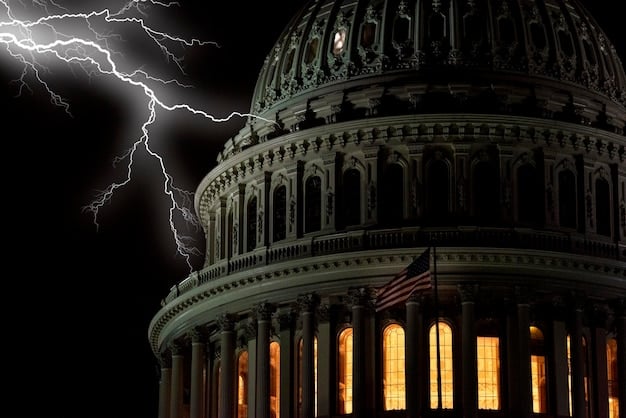The Future of the Filibuster: Senate Rule Changes in 2025

In 2025, potential changes to the filibuster rule in the U.S. Senate could significantly alter legislative processes, impacting the passage of key policies and the balance of power between parties.
The future of the filibuster: Analyzing Potential Senate Rule Changes in 2025 is a topic of intense debate in American politics, with potential reforms looming that could reshape the legislative landscape. As the Senate grapples with gridlock and partisan divides, understanding the nuances of the filibuster and the potential consequences of its alteration is crucial.
Understanding the Current State of the Filibuster
The filibuster, a parliamentary procedure in the Senate, allows a minority of senators to delay or block a vote on a bill or other measure. Understanding its current state is essential before considering potential changes in 2025.
What is the Filibuster?
At its core, the filibuster is a tactic used to extend debate on a proposal, preventing it from coming to a vote. This tool has evolved over time, impacting how legislation is passed in the Senate.
The 60-Vote Threshold
Currently, most legislation requires 60 votes to overcome a filibuster and proceed to a final vote. This supermajority requirement often leads to bipartisan negotiations and compromises, but also to legislative gridlock.

Here are key aspects of the current filibuster rules:
- Requires 60 votes to invoke cloture and end debate.
- Can be used on most legislation, including nominations.
- Often leads to lengthy debates and procedural hurdles.
Understanding the current state of the filibuster is crucial for assessing the potential impact of any rule changes in 2025.
Historical Attempts to Reform the Filibuster
Throughout history, there have been numerous efforts to reform or eliminate the filibuster. These attempts reflect ongoing debates about the balance between minority rights and majority rule in the Senate.
Past Reform Efforts
From changes to the cloture rule to carve-outs for specific types of legislation, various reforms have been proposed and implemented over the years. These efforts provide valuable context for understanding current debates.
The Nuclear Option
One controversial approach to filibuster reform is the “nuclear option,” which involves reinterpreting Senate rules to lower the threshold for cloture on certain matters. This tactic has been used sparingly but has had significant consequences.
Consider these examples of past reform attempts:
- Changes to the cloture rule in 1917 and 1975.
- Use of the nuclear option to eliminate the filibuster for judicial nominations.
- Ongoing debates about further reforms to address legislative gridlock.
Examining these historical attempts offers insights into the challenges and possibilities of filibuster reform in 2025.
Potential Rule Changes Under Consideration
As the Senate looks ahead to 2025, several potential rule changes are being considered to address concerns about legislative gridlock and partisan obstruction. These proposals range from modest reforms to more radical overhauls of the filibuster.
Lowering the Vote Threshold
One proposal involves lowering the threshold for invoking cloture from 60 votes to a simple majority. Proponents argue that this would make it easier to pass legislation and overcome partisan obstruction.
The Talking Filibuster
Another option is to restore the “talking filibuster,” which would require senators to continuously debate a bill in order to delay or block a vote. This approach aims to make the filibuster more transparent and accountable.

Here are some potential rule changes being discussed:
- Reducing the number of votes needed for cloture.
- Restoring the talking filibuster.
- Creating exceptions for certain types of legislation.
These potential rule changes reflect a range of perspectives on how to improve the functioning of the Senate.
Arguments For and Against Filibuster Reform
The debate over filibuster reform is often framed as a clash between competing values, such as minority rights, majority rule, and the importance of bipartisan compromise.
Preserving Minority Rights
Opponents of filibuster reform argue that it is essential for protecting the rights of the minority party and preventing the passage of radical legislation. They contend that the filibuster encourages consensus-building and prevents the tyranny of the majority.
Promoting Majority Rule
Proponents of filibuster reform argue that it is necessary to ensure that the will of the majority is not thwarted by a small minority of senators. They contend that the filibuster leads to gridlock and prevents Congress from addressing pressing national problems.
Arguments for and against filibuster reform often revolve around these themes:
- Protecting minority rights versus promoting majority rule.
- Encouraging bipartisan compromise versus addressing legislative gridlock.
- Preserving the traditions of the Senate versus adapting to changing political realities.
Understanding these competing arguments is crucial for evaluating the potential consequences of filibuster reform in 2025.
Potential Impacts on Legislative Outcomes
Changes to the filibuster could have far-reaching consequences for the types of legislation that Congress is able to pass. A more streamlined legislative process could lead to significant policy changes in areas such as healthcare, immigration, and climate change.
Healthcare Reform
With a lower threshold for cloture, Democrats might be able to advance proposals to expand access to healthcare and lower prescription drug costs. Republicans, on the other hand, might find it easier to repeal or modify existing healthcare laws.
Immigration Policy
Filibuster reform could also pave the way for comprehensive immigration reform, as well as changes to border security and enforcement policies. The outcome would depend on which party controls the Senate and the White House.
Consider these potential impacts on legislative outcomes:
- Easier passage of healthcare reform.
- Potential for comprehensive immigration reform.
- Changes to environmental regulations and energy policy.
These are just a few examples of how filibuster reform could reshape the legislative landscape.
Political Maneuvering and Party Strategies
The debate over filibuster reform is often driven by political calculations and strategic considerations. Each party has its own set of goals and priorities, and the fight over Senate rules is often a proxy for broader ideological battles.
Democratic Strategies
Democrats, who have often been frustrated by Republican obstruction, are more likely to support changes to the filibuster. They see reform as a way to advance their policy agenda and overcome partisan gridlock.
Republican Strategies
Republicans, who have benefited from the filibuster in the past, are more likely to oppose changes to the rule. They see it as a way to protect their priorities and prevent the passage of liberal legislation.
Political maneuvering and party strategies play a key role in the debate over filibuster reform:
- Democrats seek to overcome Republican obstruction.
- Republicans seek to protect their priorities.
- The filibuster debate is often a proxy for broader ideological battles.
Understanding these dynamics is essential for predicting the future of the filibuster in the Senate.
| Key Point | Brief Description |
|---|---|
| 🏛️ Filibuster Basics | A Senate procedure to delay or block a vote on a bill. |
| 🗳️ 60-Vote Rule | Most bills need 60 votes to end a filibuster and pass. |
| 🔄 Potential Changes | Options include lowering the vote threshold and restoring the talking filibuster. |
| ⚖️ Legislative Impact | Reforms could significantly impact healthcare, immigration, and more. |
Frequently Asked Questions
▼
Currently, it requires 60 votes in the Senate to invoke cloture and end a filibuster, allowing a bill to proceed to a final vote.
▼
The “talking filibuster” requires senators to continuously debate a bill to delay a vote, unlike the current practice where they don’t need to hold the floor.
▼
Filibuster reform is considered to address legislative gridlock and partisan obstruction in the Senate, aiming to make the legislative process more efficient.
▼
Filibuster reform could make it easier for the Senate to pass or repeal healthcare laws, depending on which party has the majority.
▼
The main arguments against reform include protecting minority rights and encouraging bipartisan compromise in the Senate.
Conclusion
The future of the filibuster remains uncertain, but the debate over potential rule changes in 2025 underscores the ongoing tension between minority rights, majority rule, and the need for effective governance in the U.S. Senate. Any reform could reshape the legislative landscape, impacting policy outcomes and the balance of power between parties.





